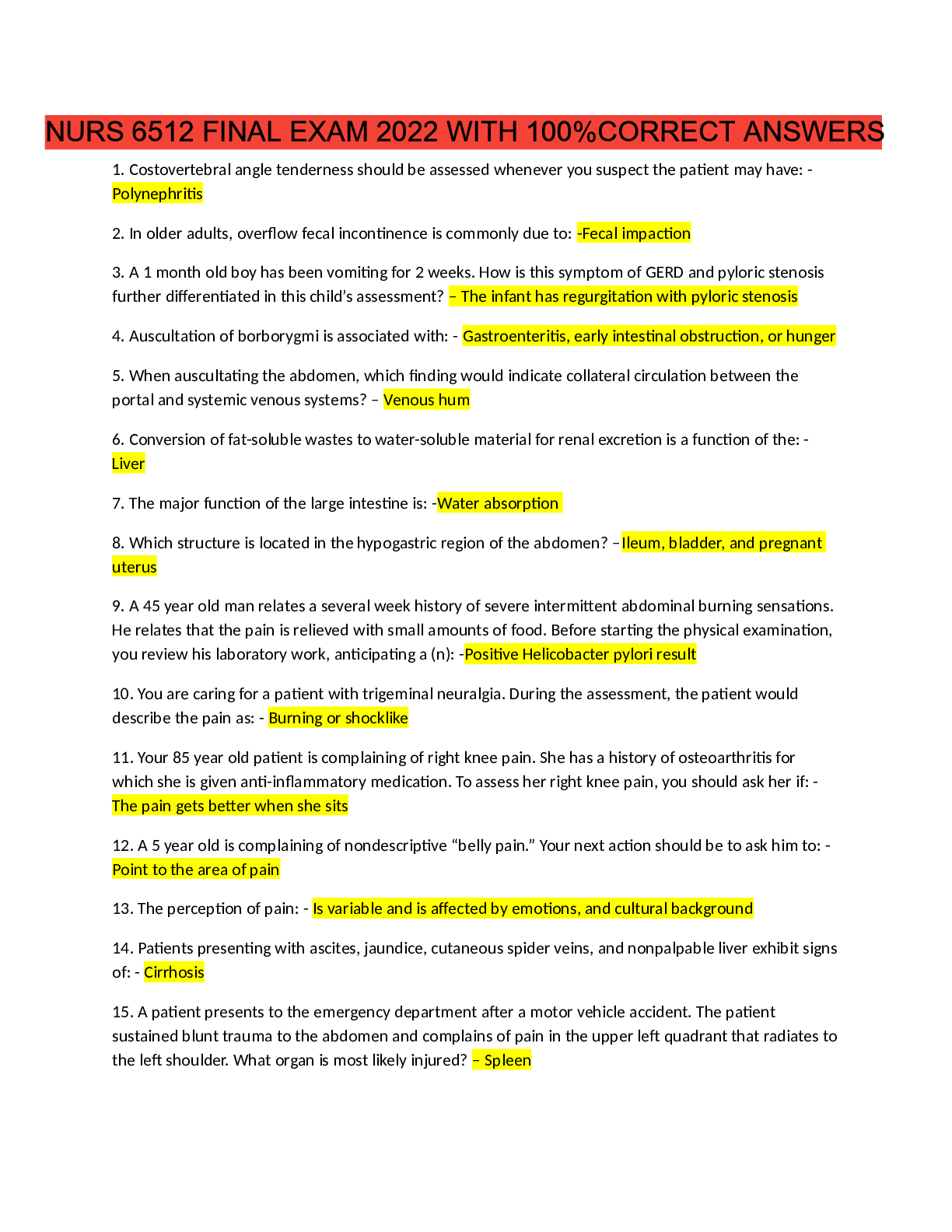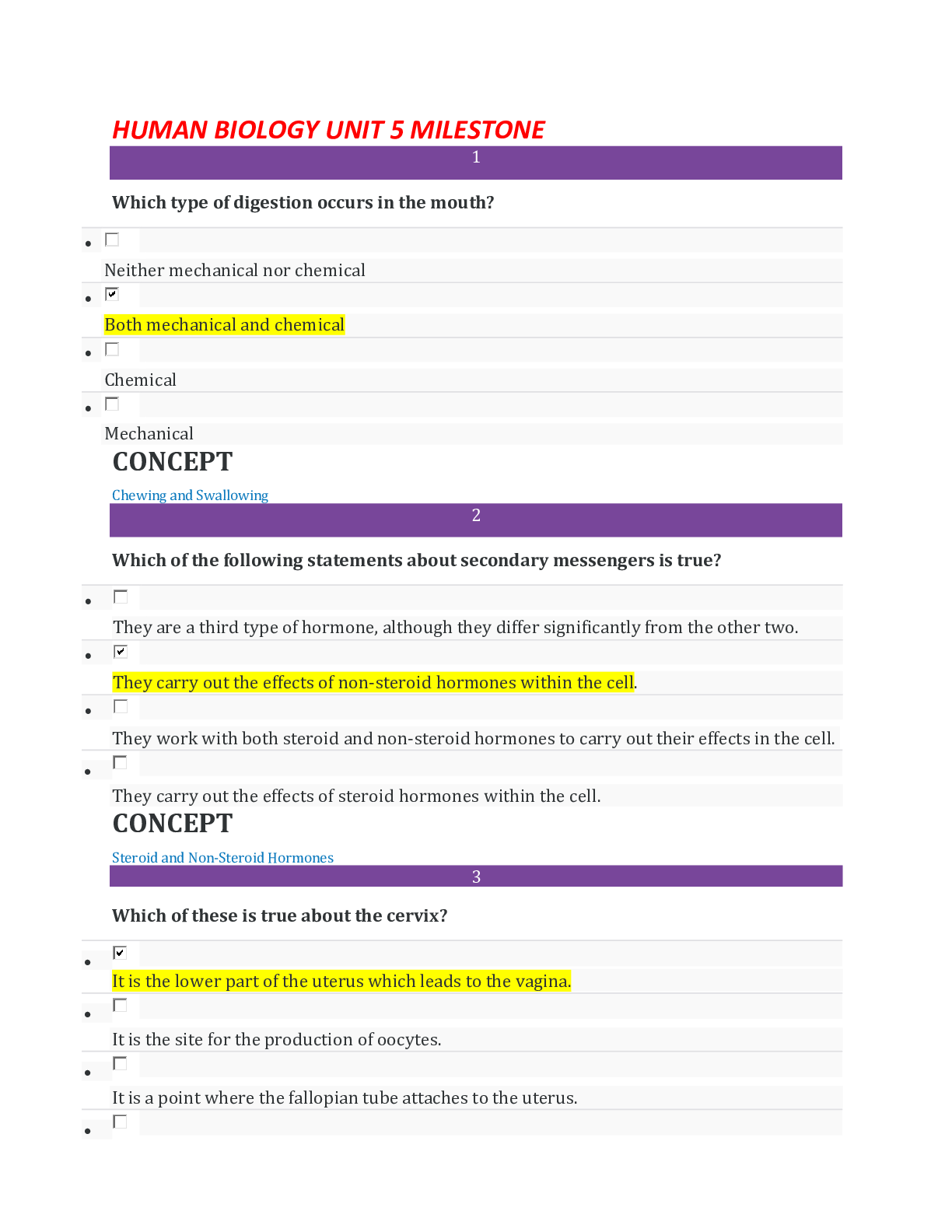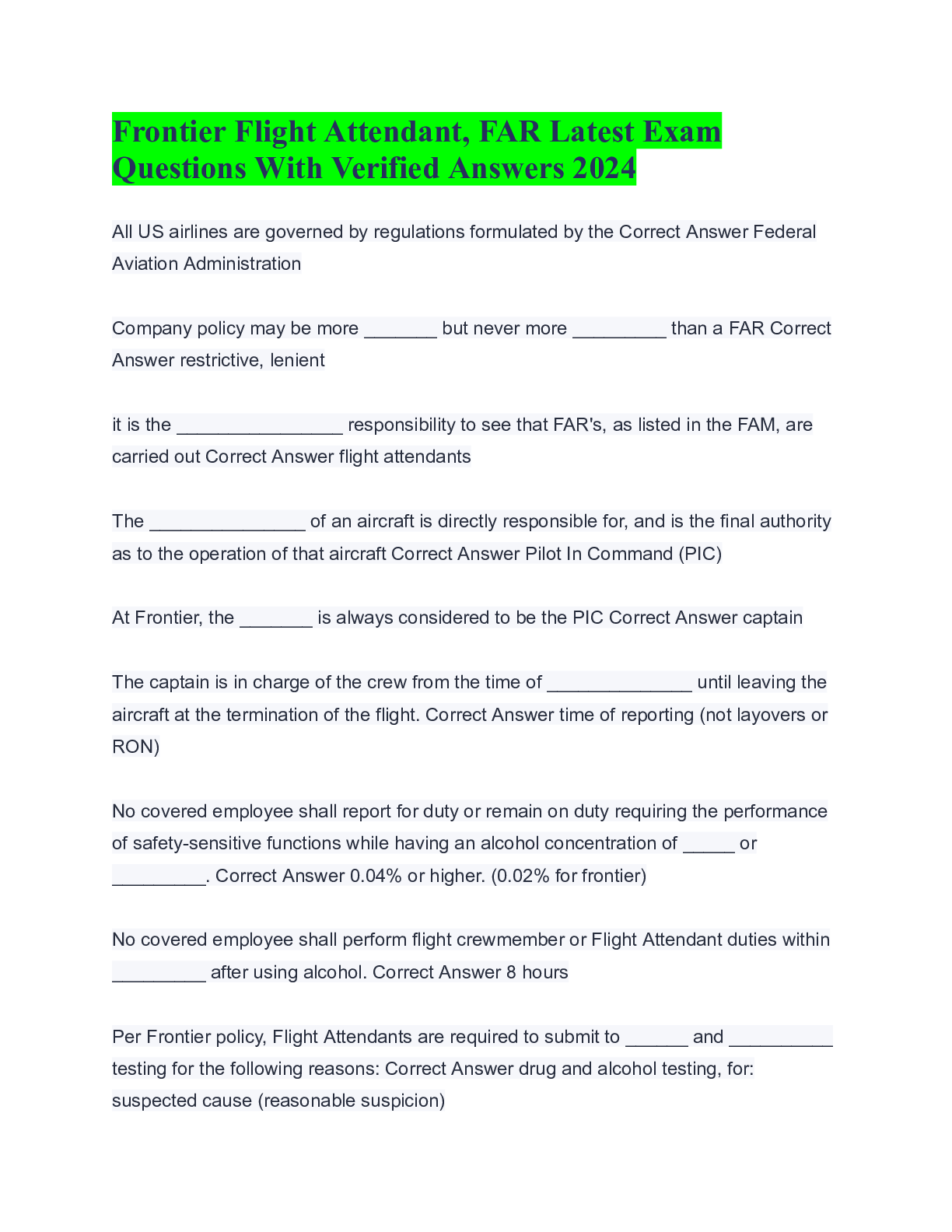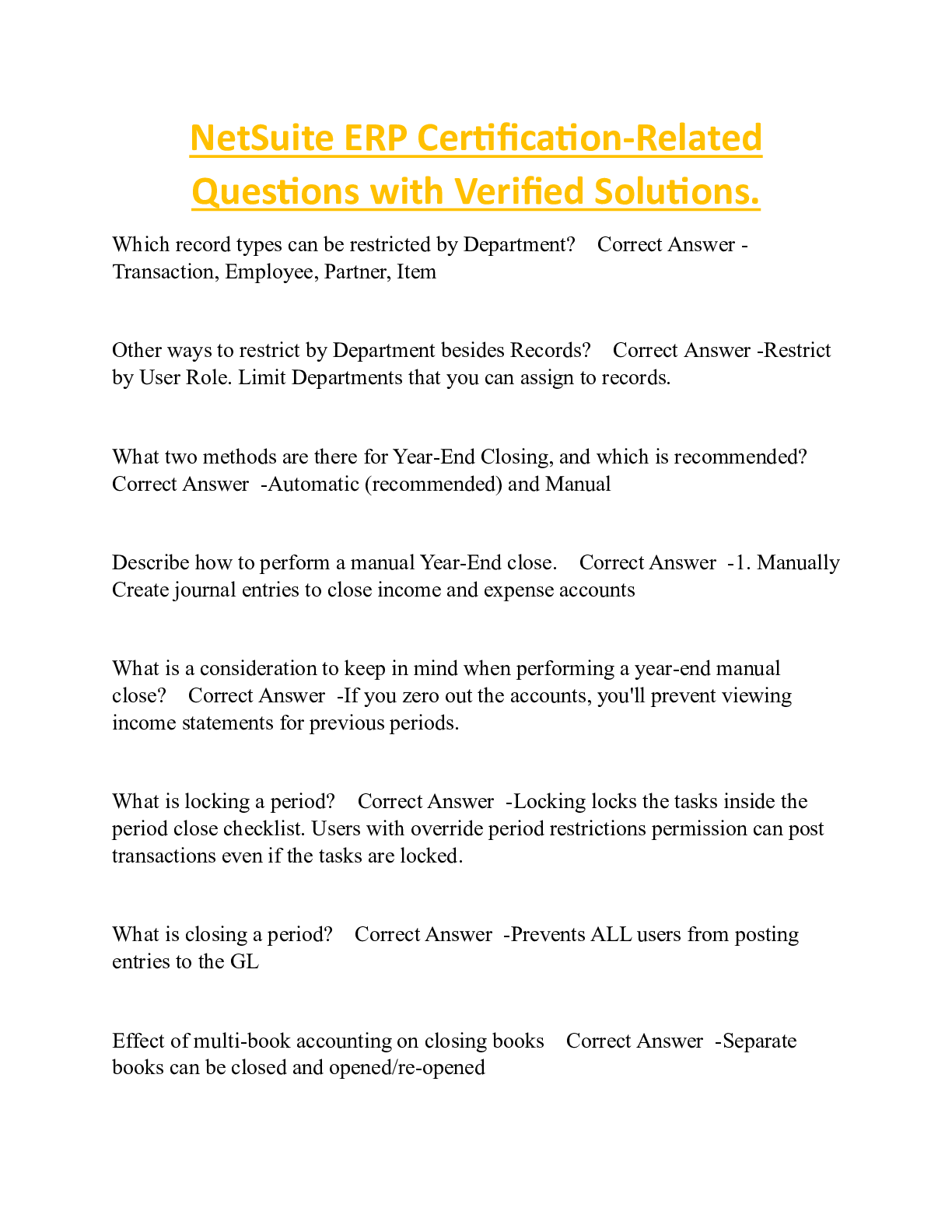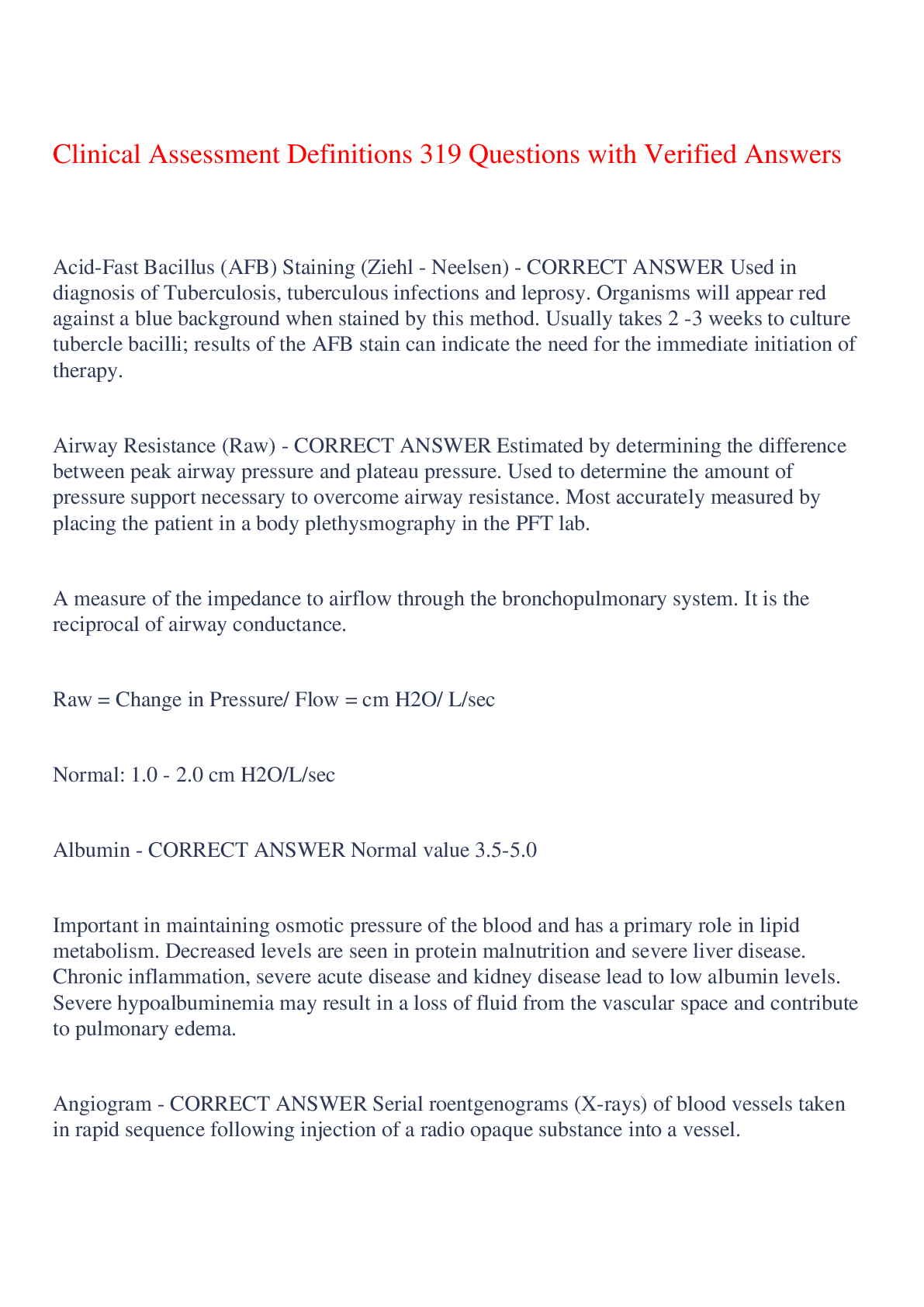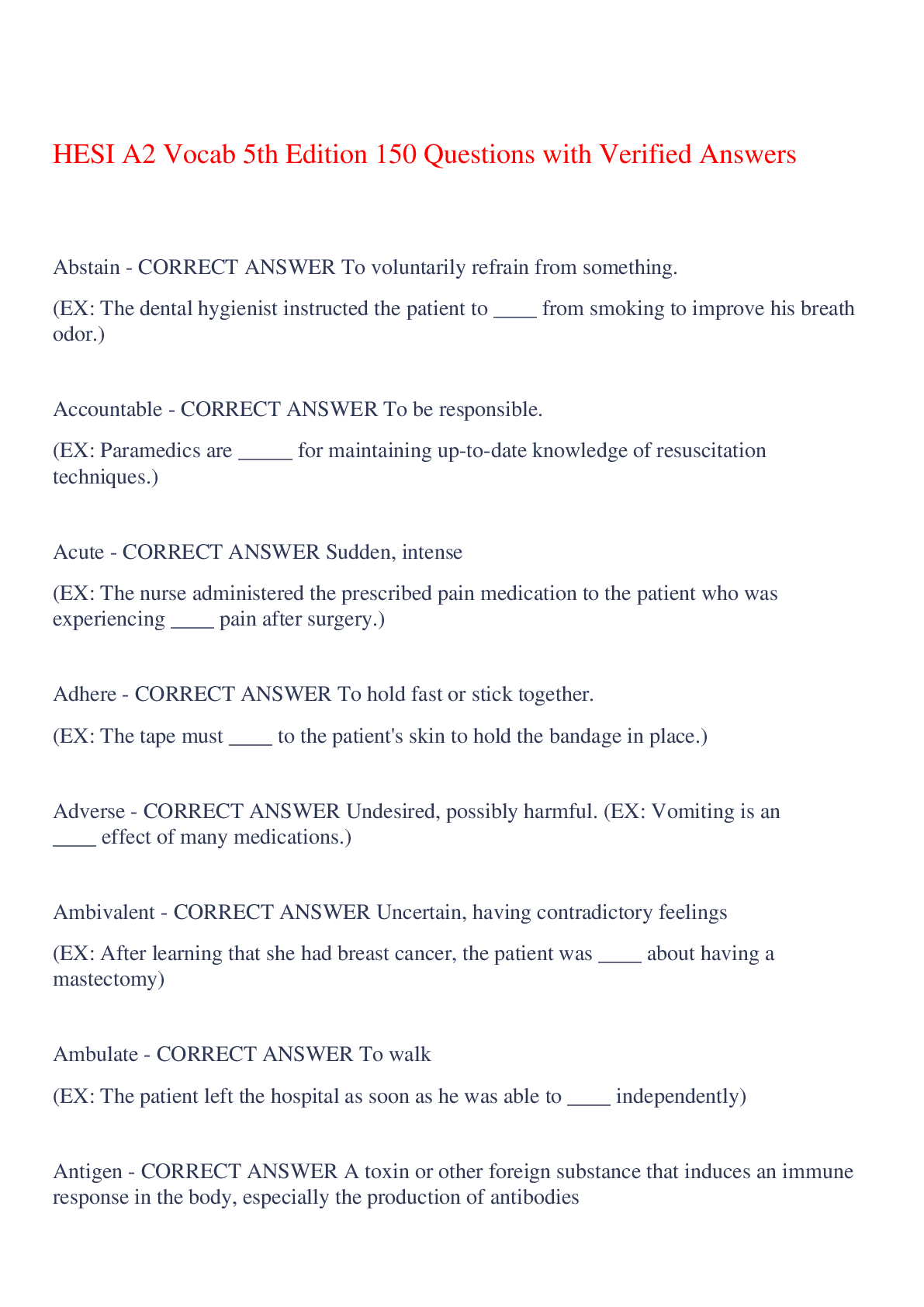Roles of Nurse Exam 48 Questions with Verified Answers,100% CORRECT
Document Content and Description Below
Roles of Nurse Exam 48 Questions with Verified Answers 1. What are the difference between the models that exist in the healthcare system and the models of care provided by the NP? - CORRECT ANSWER ... Primary prevention/Health promotion Secondary prevention/early detection Tertiary prevention/disease managment Discuss the components of primary care. - CORRECT ANSWER Primary Care: • Forms broad and deep base of HC system by providing initial and continuing care and access to other types/levels of care • Accessible, prevention-oriented, general wellness and illness care of individuals and families • Woven through ambulatory sites, homes, and residential settings such as nursing homes and prisons • Categories used to define primary care: o Care provided by certain clinicians o Set of activities o Level of care o Setting for care o Set of attributes (accessible, accountable, comprehensive, coordinated, continuous) o Strategy for organizing Health Care System (community-based, COPC) Secondary care - CORRECT ANSWER Disease specific care Tertiary care: - CORRECT ANSWER Emergent and critical care • One out of 1000 patients • Health professional education here • Research and textbooks here • Clinical pathways/care standards developed here What is the role of the primary care provider? - CORRECT ANSWER Using a recognized scientific knowledge base to direct the delivery of personal health services to patients Who are the providers of primary care? - CORRECT ANSWER • APNs and other first contact providers • IOM: an individual who uses a recognized scientific knowledge base and has the authority to direct the delivery of personal health services to patients What does the Institute of Medicine (IOM) define as primary care? - CORRECT ANSWER • The provision of integrated, accessible HC services by clinicians who are accountable for addressing a large majority of personal HC needs developing a sustained partnership with patients and practicing in the context of family and community • Focus on personal health services not public health or populations • Scope of primary care: acute, chronic, prevention, coordination of referrals What are the models often found in primary care and their structure. - CORRECT ANSWER • Community oriented Primary care (COPC): Blend of primary care and public health • Community Partnerhsip Primary Care : Blend of COPC and community development o Uses Primary care as stratgety and resource to helpf community develop knowledge, skills, and actions to help itself • Pateint Centered Medical Home (PCMH) • Convenient Care Clinic Model (CCCM) What is demand management - CORRECT ANSWER A group of support systems that enable and encourage consumers to use medical care appropriately, not as a means of increasing or decreasing patents' demand for care o Based on supply and demand o Strategies involve managing HC resources ie number of beds, number of providers, staffing o Personal beliefs and effects of social networks account for 42% of the variance in the patient decision to seek care versus morbitity with 12% variance disease management - CORRECT ANSWER • Disease management: Systems based, physicians directed, proactive care management of the total patient across the continuum of care with the goal of enhanced patient outcomes and reduced total cost of care o Focuses on the demand side/patient care side of the equation o Seeks to cut costs and improve care by helping patients make better decisions o Focus is on improving health behaviors and decisions disease management: 7 crucial elements - CORRECT ANSWER • defined population • risk stratification • clinical guidelines • coordinated delivery systems • provider support and education • patient support and education • outcomes management Who implements Case Management? What are the components of Case Management? - CORRECT ANSWER • A systematic process of mobilizing, monitoring, and controlling the resources that a patient uses over the course of an illness • CNS developed CM models, and now BS nurses implement • This coordinated care is an integral part of nursing LACE - CORRECT ANSWER • Licensure is the granting of authority to practice. • Accreditation is the formal review and approval by a recognized agency of educational degree or certification programs in nursing or nursing-related programs. • Certification is the formal recognition of the knowledge, skills, and experience demonstrated by the achievement of standards identified by the profession. • Education is the formal preparation of APRNs in graduate degree-granting or post-graduate certificate programs. 4 roles - CORRECT ANSWER Clinical Nurse Specialists, CRNA, Certified nurse midwives, Nurse practitioners 6 Population foci - CORRECT ANSWER psych/mental health, women's health/gender specific, adult-gerontology, pediatrics, neonatal, family What is the purpose of the Consensus Model? - CORRECT ANSWER To bring clarity to, and standardization of, advanced practice nursing roles; promotes uniformity and standardization of the APRN role for the safety of the consumer of health care. 1. Who is credited to be the first advanced practice nurse role? - CORRECT ANSWER • Psych was first CNS: Hildegard Peplau in 1953 at Rudger's University; title first 2. Who is credited to be the founder of the first nurse practitioner role? - CORRECT ANSWER • First NP was Pediatric NP: Loretta Ford/Henry Silver MD in 1965 at the University of Colorado 3. Who is (are) the oldest primary care providers in the history of advanced practice - CORRECT ANSWER • Midwives in the 1700s • Anesthesia in the 1800s; Less MD anesthetists in WWI 5. What is NONPF? What is their influence for APRNs? - CORRECT ANSWER National Organization of Nurse Practitioner Faculty: Developed domains and competencies in 1995; Organization responsible for curriculum for NPs; 2011 Competencies: a. Scientific Foundations Competencies b. Leadership Competencies c. Quality Competencies d. Practice inquiry Competencies e. Technology and Information Literacy Competencies f. Policy Competencies g. Health Delivery Systems Competencies h. Ethics Competencies PA vs NP - CORRECT ANSWER PA: began in the 1960's • First program at Duke • Regulated under state medical practice acts • Generally licensed a dependent to physicians • Work under the direction of the physician to provide medical care • Focus on medical tasks utilizing a medical framework • Considered capable of providing approx. 75% of physician-specific services • Has a job description not a scope of practice NP: • Focus on multiple practice and nursing models • Have independent and dependent functions from the physician • Has a scope of practice OTA - CORRECT ANSWER Commissioned by congress to research the effectiveness of NPs, CNM, and PAs • APNs better at providing services that depend on communication and prevention • Quality of care: can compare with MDs only on those functions that both perform equally • Pt satisfactions • Access to care • Payment/costs Brown: - CORRECT ANSWER Patient satisifaction and resolution of pathological conditions were greater for NPs over MDs • NPs used less technology and analgesia than MDs in intrapartum care • NMs achieved neonatal outcomes equivalent to MDs Safriet: - CORRECT ANSWER Identifies that there is abundant data on NP role in providing high quality, cost effective care • There re major restrictions on the practice of NPs o Scope of practice o Prescriptive authority o Elegilizity for reimbursement • NPs are a solution to healthcare systems issues such as access to care quality of care and cost of care • In order to be part of the solution, barriers to practice must be removed: o Scope of practice: protocols o Granted full authority to practice without supervision o Unlimited prescriptive authority o Full reimbursement o Autonomy as a provider (i.e. hospital privileges) Mundinger: - CORRECT ANSWER Compared outcomes for patients in randomly assigned to NPs or MDs for primary care • Outcome measures: o Patient satisfaction, health status of DM, HTN, asthma,; physiology test results and service utilization • Conclusions: NPs with the same authority, responsibilities, productivity, and administrative requirements and patient populations: the patient outcomes were comparable 1. Describe the components of a NP position description plan. - CORRECT ANSWER • Role • Qualifications • Job duties (tasks and abilities) • Administrative duties 2. What are the duties most often found in a position description? - CORRECT ANSWER • Tasks as well as abilities • Tasks: Provide physicals, examinations, care and treatment • Initiate and interpret x-rays, tests, labs • Abilities: Managing specific disease processes for inpatients • Managing specific disease processes for outpatients • Providing patient education 3. What are the differences in job duties and administrative duties for a positions plan? - CORRECT ANSWER • Job duties: • Administrative duties: Following policies and procedures o Documentation standards o Continuing education requirements • 4 Key Elements of a Contract: - CORRECT ANSWER • Capacity of the parties: One party cannot withdraw without the other's agreement • Mutual agreement or meeting of the minds; A valid offer and the acceptance of the offer • Consideration: Something of value is given in exchange for some promise • Legality of the subject matter of the contract: The legal concept of the offer Contract Components: - CORRECT ANSWER • Scope: Includes the activities governed by the agreement; should be within the scope of practice • Effective date: when does the agreement begin? • Relationship and responsibilities of the parties o Describes the working relationships between the parties o Is the ANP an employee or independent practitioner? o An independent practitioner should not have language that dictates when, where and how service is performed o An employee has language that dictates when, where, and how service is performed • Confidentiality: How are documents and info handled? HIPPA • Conflicts of interest: both agree to support the mutual success of the other • Compensation: payments for agreed upon services; when, how much, how often; Bonuses and how are they tabulated? • Indemnification and subrogation: o Indemnification: agreement of both parties to hold the other harmless for wrongdoing by the other party o Subrogation: Describes the process to be followed when there is a disagreement betw 5. What are the differences between a NP independent contractor and NP employed by an organization? - CORRECT ANSWER • Independent contractor: o Contracted by but not controlled by another for something o Incurs liability for acts that are within the scope of practice o Do not have Respondent Superior: an employer is responsible to the acts of the employee Practice management includes what elements according to Buppert/ the class notes. - CORRECT ANSWER Hiring, firing, staffing • Exterior, interior • Front desk • Billing and reimbursement • Policies and procedures • Clinical productivity 7. Malpractice Insurance: - CORRECT ANSWER • Occurrence policy: covers any incident that occurred while the NP was insured • Claims Made policy: An NP is covered only when the policy is in affect, no matter when the occurrence happened • Trait: - CORRECT ANSWER Set of characteristics that inspire others • Style: - CORRECT ANSWER Relational, what "do" in relationships • Situational or Contingency Leadership: - CORRECT ANSWER adaptive, combination of task, relational skills, and environment ... - CORRECT ANSWER o Connection of leadership with purpose o Leaders work with followers to gain some type of exchange for services that are contracted by the leader o Leaders look for motivation and engage the whole person for a common purpose o Leaders look beyond their own self interest to that of the followers o Crediability is important o 5 principals: modeling the way; inspiring a shared vision; challenging the process; enabling others to act; encouraging the heart Situational or Contingency Leadership: - CORRECT ANSWER o Different styles of leadership are needed in different situations o Dependent on the maturity and competence of the subordinates and the situation that is presented to the leader o Acitivites of Leadership: telling when there is very low maturity; selling to those with moderate maturity; participating for those with moderately high maturity; and delegation for those with very high maturity o Leadership style depends on the difficulty of the task and the maturity/competence of the persons responsible for the tasks • Servant Leadership: - CORRECT ANSWER o Leader who wants to serve first versus being the leader o Focus on meeting the needs of others and accomplishing the work o Anyone can be a leader by meeting the needs of others o Characteristics: active listening; empathy, healing, awareness, persuasion, stewardship; commitment to the development of others, foresight, and building community o 7 pillars on which servant leadership grows: - CORRECT ANSWER personal character • an ethic of the people first • skilled communicator • compassionate collaborator • possessing foresight • systems thinker • leader with moral authority • Transformational and Transactional Leadership: - CORRECT ANSWER Collaborative, consultative, consensus building Transformational and Transactional Leadership: - CORRECT ANSWER o Connection of leadership with purpose o Leaders work with followers to gain some type of exchange for services that are contracted by the leader o Leaders look for motivation and engage the whole person for a common purpose o Leaders look beyond their own self interest to that of the followers o Crediability is important o 5 principals: modeling the way; inspiring a shared vision; challenging the process; enabling others to act; encouraging the heart • Relational Leadership - CORRECT ANSWER o Mutual agenda between leader and follower o Inclusiveness of others, and the ability to persuade others to your way of thinking o Teams evolve their own culture • Clinical Leadership/Congruent Leadership - CORRECT ANSWER o Matching the clinical leaders' action and their values and beliefs about care and nursing o Theoretical foundation on which clinical nurses can build their capacity to be clinical leaders o Focus on the patient first 2. What are the Leadership tasks? Describe? (10) - CORRECT ANSWER • Envision goals • Affirm values • Motivate • Manage • Achieve Unity • Develop trust • Explain • Serve as symbol • Represent the group • Renew 3. Covey identifies effective characteristics of leadership to be what? (8) - CORRECT ANSWER • Continuously engage in lifelong learning • Service oriented • Concerned with the common good • Radiate positive energy • Believe in other people • Lead balanced lives • Synergistic world view • Engage in self renewal 4. What skills as a change agent are needed by the NP? (8) - CORRECT ANSWER • Excellent communicator • Good observer • Knowledge of group dynamics • Perceptive re: political issues • Supportive attitude • Ability to establish trusting relationships • Ability to resolve and deal with conflict • Credibility 5. Discuss the leadership expectations of masters prepared nurses functioning as NPs. (5) - CORRECT ANSWER • Facilitate clinical development of others • Coach others in interpreting, forecasting, responding to patients • Bridge the gaps in patient care • Build and preserve collaborative relationships • Transform care delivery systems Medicare and Medicaid reimburse the NP at what percentage of the physician's reimbursement? - CORRECT ANSWER NPs reimbursed 92% normal physicians rate in Texas • NONPF: National Organization of Nurse Practitioner Faculty: - CORRECT ANSWER Developed domains and competencies in 1995; Organization responsible for curriculum for NPs; 2011 Competencies: What are the renewal requirements of the certification by the recognized organization(s) - CORRECT ANSWER • Recertification is according to agency specification • ANCC: Every 5 years • 1000 hours of clinical • 150 hours of CE; must include 25 hours of pharmacology • Current RN license • Category 1: 75 contact hours including pharmacology • Category 2: academic credit 5 semester hours • Category 3: Lecture/presenter credits: 5 or more different presentations • Category 4: Publications/Research • Category 5: Preceptorships: 120 hours • Category 6: Professional: Volunteer service 2 years What are the 6 tips to avoid as listed by ANA? - CORRECT ANSWER Remember that standards of professionalism are the same online as in any other circumstance. 2.Do not share or post information or photos gained through the nurse-patient relationship. 3.Maintain professional boundaries in the use of electronic media. Online contact with patients blurs this boundary. 4.Do not make disparaging remarks about patients, employers or co-workers, even if they are not identified. 5.Do not take photos or videos of patients on personal devices, including cell phones. 6.Promptly report a breach of confidentiality or privacy. [Show More]
Last updated: 6 months ago
Preview 1 out of 12 pages
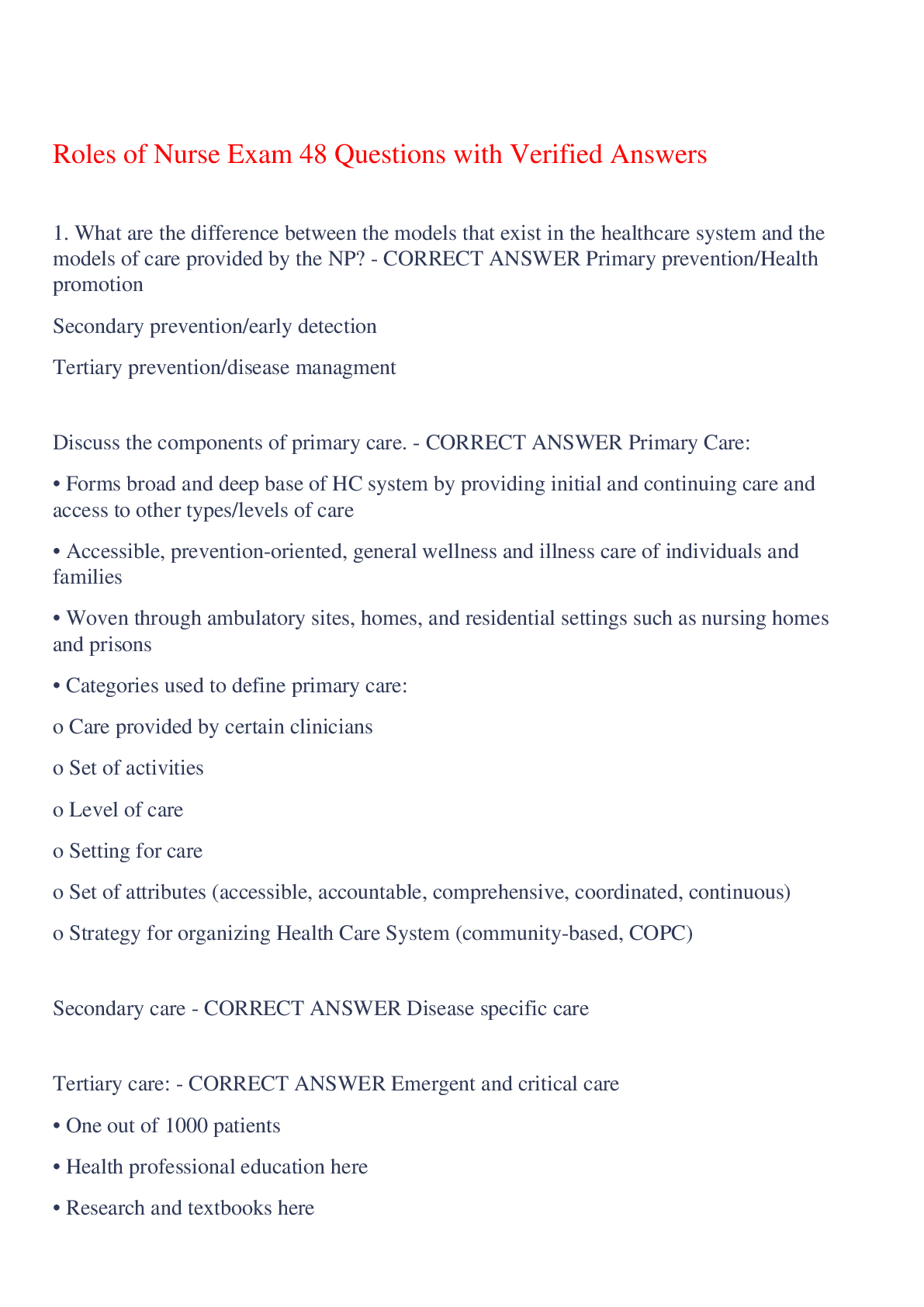
Reviews( 0 )
Document information
Connected school, study & course
About the document
Uploaded On
Nov 03, 2023
Number of pages
12
Written in
Additional information
This document has been written for:
Uploaded
Nov 03, 2023
Downloads
0
Views
6




